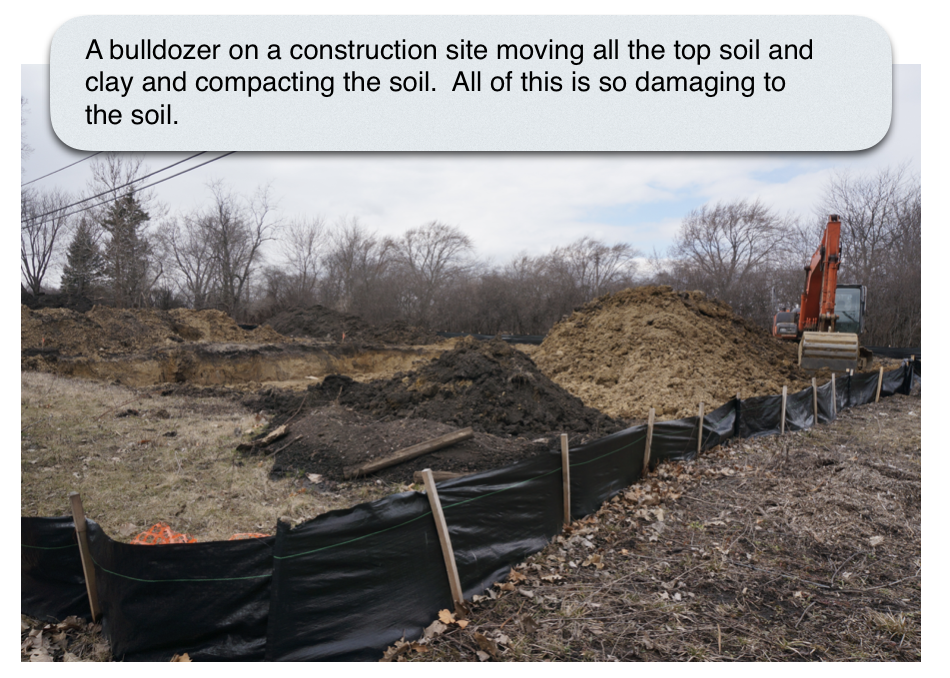“Lovingly” Preparing the Soil for Planting
/by: Gilbert A Smith, ISA BC Master Arborist
Backyard Wisdom September 2019
Typical construction site. Photos by Gilbert A Smith.
Years down the road from the time your landscape was originally planted, Arborsmith Ltd. is called in to diagnose tree problems. Why is my River Birch doing so poorly when my neighbor’s is healthy? It is hard to answer that question without going back to the original construction. Most of our tree problems begin and end with the soil. We can’t see under the ground. We can test the soil and sample the leaves but all we have to do is move 10 feet away and the soil conditions change. Let me tell you the story of a typical suburban soil and how it affects tree health.
First, let me say that Illinois soil is some of the most fertile, productive soil in the world. Before construction begins, there is often 18 inches of beautiful, black top soil suitable for growing almost anything. Farmers from around the world would die for such fertile soils and yet we take this rich heritage for granted. Prairie does best here, with a few great Oaks and Hickories. We are not a forest state like Michigan, Indiana, Ohio, or the Eastern states and the reason for this is the thick clay layer just below the top soil. Clay does not allow water to drain through it, so water sits and drowns tree roots. Prairie plants love it but not trees and especially not evergreen trees.
When home construction begins, all of the top soil is scraped off and often sold to the neighbors. This is not a sinister plan. The short story is that it is just the most efficient way to build homes. Next, the digging is done for the concrete foundations bringing up heavier clay from 8 feet under, which is an even worse growing medium. This is often spread near the house as back fill, as a base for walks and to even out the landscape. Before the construction, the land has spent 10,000 years establishing drainage patterns to move the water away. Bull dozers are efficient at moving the soil, but as a side effect, they compact it to the consistency of cinder block and interrupt any natural drainage, causing dams, ponds and septic conditions that are toxic to tree roots.
I hate to keep piling it on but because contractors do not understand that soil is a living, breathing organism they dump limestone on the clay, the concrete trucks clean out their waste, gypsum debris and paint brush cleaning are done in the dirt because they don't want to pollute the driveways. All of these activities are toxic to soil and plant roots both now and in the long term.
When the house is complete, a thin layer of top soil is spread over the clay, and sod, trees and flowers are planted. I must repeat, this is not an evil plan to kill soil and trees. It is done out of ignorance of the valuable asset that our whole landscape is founded on, the soil.
So what are we to do? I wish I had some magical answers. Most of the time we buy our house after all of the damage has been done. I’m writing this to explain a conundrum that Lesley and I encounter every day and no simple fix like spraying or fertilizing can undo the damage. I wish that more home builders would follow the pattern established by George and Vicky Ranney when they developed Prairie Crossing in Grayslake. They respected the soil, kept the houses in a limited area and maximized the land development for a healthy living environment and a beautiful neighborhood. If you haven't visited Prairie Crossing you are in for a treat. It is world renown in its innovation and conservation.
Here are a few more suggestions:
Plant plants that are adaptable to soggy, polluted, clay, conditions.
But that’s no fun because there are very few of these plants, so plant your plants high (half of the ball should be out of the ground with good light compost brought up to cover the root ball).
Mulch, Mulch, Mulch! This cannot be stressed enough. Mulching is the single most beneficial action you can take for the health of your landscape. (Ask for our Mulching AbstractTM) This is what the Chicago Botanic Garden and the Morton Arboretum do.
Hire a thoughtful Landscape Architect who will sample your soil and not just plunk expensive plants into the dirt.
Mother Nature’s Moment • How to Choose an arborist?
ISA True Professionals of Arboriculture




